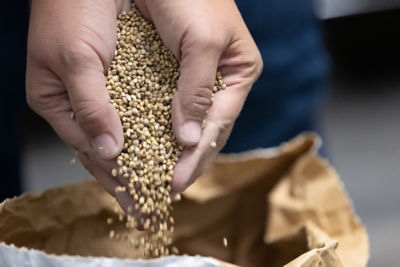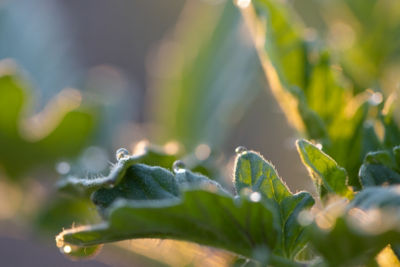Click here to download a PDF version of this spotlight.
» Edema is a non-infectious disorder that causes protuberances to form on leaf surfaces.
» Edema is a result of growing conditions causing increased water pressure in the leaves.
» Edema can develop on cabbage, cauliflower, and other Brassica crops.
Edema (or oedema) is a non-contagious, abiotic disorder that can occur on plants in both field and greenhouse production systems resulting from environmental conditions.1,2 It can occur on the leaves of many Brassica crops, especially cabbage and cauliflower, and occasionally on broccoli.2,3,4 Edema affects the appearance of the leaves, which can potentially lower quality and marketability (Figure 1).
CAUSE
Edema occurs when a plant absorbs water from the soil through its roots faster than water is transpiring from the leaves. This imbalance results in increased water pressure in the leaf tissue. Edema most commonly occurs when the soil moisture content is high and conditions do not favor rapid transpiration. Conditions that may reduce a plant’s transpiration rate include cool air temperatures, high relative humidity, or periods of prolonged cloudy weather. Warm daytime temperatures followed by cool nighttime temperatures also favor the development of edema.1,2,3,4
SYMPTOMS
Symptoms of edema can occur in random locations on the surfaces of cabbage leaves. The buildup of water pressure in the vascular system pushes water into the cells within the leaf (mesophyll cells). As a result of the pressure, the cells enlarge and protrude through the leaf surface, resembling wart-like growths (Figure 1).
 Figure 1. Protuberances on the underside of a cabbage leaf resulting from edema. Joseph LaForest, University of Georgia, Bugwood.org.
Figure 1. Protuberances on the underside of a cabbage leaf resulting from edema. Joseph LaForest, University of Georgia, Bugwood.org.
Eventually, the cells burst, releasing the cellular contents into the intercellular space in the leaf and giving the affected area a water-soaked appearance. The wounded tissues then heal and form corky protuberances (swellings) that are yellow to tan to brown (Figure 2). The affected areas on cabbage leaves may become covered with powder-like deposits. The damage is superficial, but the symptoms can alter the appearance of the harvested product, resulting in reduced visual quality and marketability. 1,2,3,4
 Figure 2. Lesions from edema become corky and turn tan to brown with age. Gerald Holmes, Strawberry Center, Cal Poly San Luis Obispo, Bugwood.org.
Figure 2. Lesions from edema become corky and turn tan to brown with age. Gerald Holmes, Strawberry Center, Cal Poly San Luis Obispo, Bugwood.org.
Eventually, the cells burst, releasing the cellular contents into the intercellular space in the leaf and giving the affected area a water-soaked appearance. The wounded tissues then heal and form corky protuberances (swellings) that are yellow to tan to brown (Figure 2). The affected areas on cabbage leaves may become covered with powder-like deposits. The damage is superficial, but the symptoms can alter the appearance of the harvested product, resulting in reduced visual quality and marketability. 1,2,3,4
MANAGEMENT
Varieties of cabbage and other Brassica crops can differ in their susceptibility to edema. So, planting varieties that are less prone to the disorder may be helpful in areas or at times when conditions may be favorable for the edema to develop.3 Planting in fields with well-drained soils can help prevent the occurrence of edema. Efforts to improve soil drainage, such as installing drainage tiles or planting on raised beds, can also help prevent the disorder.2,3 Avoid overwatering, especially when conditions are cloudy, humid, or when temperatures are cool. Use wider plant spacings to allow adequate airflow in the canopy to promote transpiration.1,3 In greenhouse settings, keep relative humidity levels below 70% in the winter, improve ventilation and airflow in the canopy, and increase light levels to promote adequate transpiration.1,4
SOURCES
1 Hartman, J. and Gauther, N. 2021. Edema. University of Kentucky Plant Pathology Fact Sheet, PPFS-GEN-18.
2 Goldy, R. 2014. What are these bumps on my vegetables? Michigan State University, MSU Extension. https://www.canr.msu.edu/news/what_are_these_bumps_on_my_vegetables.
3 Shattuck, V. 2007. Edema. In Rimmer, S., Shattuck, V., and Buchwaldt, L., Eds. Compendium of Brassica Diseases. American Phytopathological Society.
4 Oedema. Utah State University, Utah Pests. https://extension.usu.edu/pests/ipm/notes_ag/veg-edema.
Websites verified 5/8/2024
ADDITIONAL INFORMATION
For additional agronomic information, please contact your local seed representative. Performance may vary, from location to location and from year to year, as local growing, soil and environmental conditions may vary. Growers should evaluate data from multiple locations and years whenever possible and should consider the impacts of these conditions on their growing environment. The recommendations in this article are based upon information obtained from the cited sources and should be used as a quick reference for information about vegetable production. The content of this article should not be substituted for the professional opinion of a producer, grower, agronomist, pathologist and similar professional dealing with vegetable crops.
BAYER GROUP DOES NOT WARRANT THE ACCURACY OF ANY INFORMATION OR TECHNICAL ADVICE PROVIDED HEREIN AND DISCLAIMS ALL LIABILITY FOR ANY CLAIM INVOLVING SUCH INFORMATION OR ADVICE.
7511_406702 Published 05/28/2024




